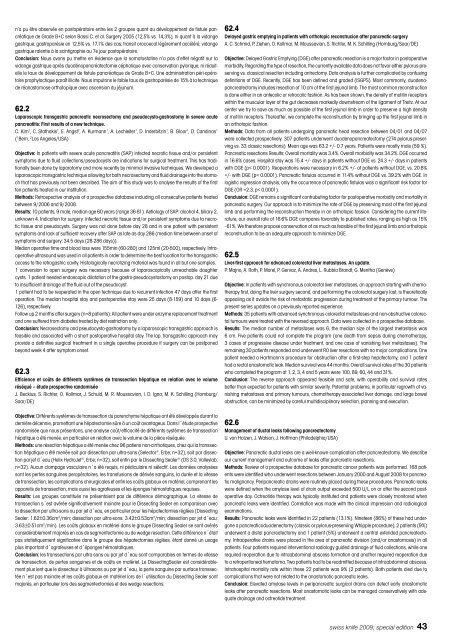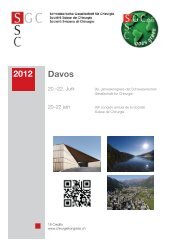Abstracts - Chirurgie Kongress
Abstracts - Chirurgie Kongress
Abstracts - Chirurgie Kongress
You also want an ePaper? Increase the reach of your titles
YUMPU automatically turns print PDFs into web optimized ePapers that Google loves.
n’a pu être observée en postopératoire entre les 2 groupes quant au développement de fistule pancréatique<br />
de Grade B+C selon Bassi C. et al. Surgery 2005 (12,5% vs. 14,3%), ni quant à la vidange<br />
gastrique; gastroparésie en 12,5% vs. 17,1% des cas; transit orocoecal légèrement accéléré; vidange<br />
gastrique ralentie à la scintigraphie au 7e jour postopératoire.<br />
Conclusion: Nous avons pu mettre en évidence que la somatostatine n’a pas d’effet négatif sur la<br />
vidange gastrique après duodénopancréatectomie céphalique avec conservation pylorique, ni réduitelle<br />
le taux de développement de fistule pancréatique de Grade B+C. Une administration péri-opératoire<br />
prophylactique paraît illicite. Nous imputons le faible taux de gastroparésie de 15% à la technique<br />
de réanastomose orthotopique avec ascension du jéjunum.<br />
62.2<br />
Laparoscopic transgastric pancreatic necrosectomy and pseudocysto-gastrostomy in severe acute<br />
pancreatitis: First results of a new technique.<br />
C. Kim 1 , C. Stathakis 1 , E. Angst 2 , A. Kurmann 1 , A. Lechleiter 1 , D. Inderbitzin 1 , B. Gloor 1 , D. Candinas 1<br />
( 1 Bern, 2 Los Angeles/USA)<br />
Objective: In patients with severe acute pancreatitis (SAP) infected necrotic tissue and/or persistent<br />
symptoms due to fluid collections/pseudocysts are indications for surgical treatment. This has traditionally<br />
been done by laparotomy and more recently by minimal invasive techniques. We developed a<br />
laparoscopic transgastric technique allowing for both necrosectomy and fluid drainage into the stomach<br />
that has previously not been described. The aim of this study was to analyse the results of the first<br />
ten patients treated in our institution.<br />
Methods: Retrospective analysis of a prospective database including all consecutive patients treated<br />
between 9/2006 and 9/2008.<br />
Results: 10 patients, 9 male, median age 60 years (range 36-81). Aetiology of SAP: alcohol 4, biliary 2,<br />
unknown 4. Indication for surgery: infected necrotic tissue and/or persistent symptoms due to necrotic<br />
tissue and pseudocysts. Surgery was not done before day 28 and in one patient with persistent<br />
symptoms and lack of sufficient recovery after SAP as late as day 286 (median time between onset of<br />
symptoms and surgery: 34.5 days (28-286 days)).<br />
Median operative time and blood loss were 155min (60-280) and 125ml (20-500), respectively. Intraoperative<br />
ultrasound was used in all patients in order to determine the best location for the transgastric<br />
access to the retrogastric cavity. Histologically necrotizing material was found in all but one samples.<br />
1 conversion to open surgery was necessary because of laparoscopically unreachable daughter<br />
cysts. 1 patient needed endoscopic dilatation of the gastro-pseudocystostomy on postop. day 21 due<br />
to insufficient drainage of the fluid out of the pseudocyst.<br />
1 patient had to be reoperated in the open technique due to recurrent infection 47 days after the first<br />
operation. The median hospital stay and postoperative stay were 25 days (8-159) and 10 days (6-<br />
126), respectively.<br />
Follow up 2 months after surgery (n=8 patients): All patient were under enzyme replacemant treatment<br />
and one suffered from diabetes treated by diet restriction only.<br />
Conclusion: Necrosectomy and pseudocysto-gastrostomy by a laparoscopic transgastric approach is<br />
feasible and associated with a short postoperative hospital stay. The lap. transgastric approach may<br />
provide a definitive surgical treatment in a single operative procedure if surgery can be postponed<br />
beyond week 4 after symptom onset.<br />
62.3<br />
Efficience et coûts de différents systèmes de transsection hépatique en relation avec le volume<br />
réséqué – étude prospective randomisée<br />
J. Beckius, S. Richter, O. Kollmar, J. Schuld, M. R. Moussavian, I. D. Igna, M. K. Schilling (Homburg/<br />
Saar/DE)<br />
Objective: Différents systèmes de transsection du parenchyme hépatique ont été développés durant la<br />
dernière décennie, promettant une hépatectomie sûre à un coût avantageux. Dans l´étude prospective<br />
randomisée que nous présentons, une analyse coût/efficacité de différents systèmes de transsection<br />
hépatique a été menée, en particulier en relation avec le volume de la pièce réséquée.<br />
Methods: une résection hépatique a été menée chez 96 patiens non-cirrhotiques, chez qui la transsection<br />
hépatique a été menée soit par dissection par ultra-sons (Selector ® , Erbe; n=32), soit par dissection<br />
par jet d´eau (Helix HydroJet ® , Erbe; n=32), soit enfin par le Dissecting Sealer ® (DS 3.0, Valleylab;<br />
n=32). Aucun clampage vasculaire n´a été requis, ni pédiculaire ni sélectif. Les données analysées<br />
sont les pertes sanguines peropératoires, les transfusions de dérivés sanguins, la durée et la vitesse<br />
de transsection, les complications chirurgicales et enfin les coûts globaux en matériel, comprenant les<br />
appareils de transsection, mais aussi les agrafeuses et les éponges hémostatiques requises.<br />
Results: Les groupes constitués ne présentaient pas de différence démographique. La vitesse de<br />
transsection s´est avérée significativement moindre pour le Dissecting Sealer en comparaison avec<br />
la dissection par ultra-sons ou par jet d´eau, en particulier pour les hépatectomies réglées (Dissecting<br />
Sealer: 1.62±0.36cm 2 /min; dissection par ultra-sons: 3.42±0.53cm 2 /min; dissection par jet d´eau:<br />
3.63±0.51cm 2 /min). Les coûts globaux en matériel dans le groupe Dissecting Sealer se sont avérés<br />
considérablement majorés en cas de segmentectomie ou de wedge resection. Cette différence n´était<br />
pas statistiquement significative dans le groupe des hépatectomies réglées, étant donné un usage<br />
plus important d´agrafeuses et d´éponges hémostatiques.<br />
Conclusion: les transsections par ultra-sons ou par jet d´eau sont comparables en termes de vitesse<br />
de transsection, de pertes sanguines et de coûts en matériel. Le DissectingSealer est considérablement<br />
plus lent que le dissecteur à Ultrasons ou par jet d´eau, la perte sanguine par surface transsectée<br />
n´est pas moindre et les coûts globaux en matériel lors de l´utilisation du Dissecting Sealer sont<br />
majorés, en particulier lors des segmentectomies et des wedge resections.<br />
62.4<br />
Delayed gastric emptying in patients with orthotopic reconstrucion after pancreatic surgery<br />
A. C. Schmid, P. Ziehen, O. Kollmar, M. Moussavian, S. Richter, M. K. Schilling (Homburg/Saar/DE)<br />
Objective: Delayed Gastric Emptying (DGE) after pancreatic resection is a major factor in postoperative<br />
morbidity. Regarding the type of resection, the currently available data does not favor either pylorus-preserving<br />
vs. classical resection including antrectomy. Data analysis is further complicated by confusing<br />
definitions of DGE. Recently, DGE has been defined and graded (ISGPS). Most commonly, duodenopancreatectomy<br />
includes resection of 10 cm of the first jejunal limb. The most common reconstruction<br />
is done either in an antecolic or retrocolic fashion. As has been shown, the density of motilin receptors<br />
within the muscular layer of the gut decreases markedly downstream of the ligament of Treitz. At our<br />
center we try to save as much as possible of the first jejunal limb in order to preserve a high density<br />
of motilin receptors. Thereafter, we complete the reconstruction by bringing up the first jejunal limb in<br />
an orthotopic fashion.<br />
Methods: Data from all patients undergoing pancreatic head resection between 04/01 and 04/07<br />
were collected prospectively. 307 patients underwent duodenopancreatectomy (274 pylorus-preserving<br />
vs. 33 classic resections). Mean age was 63.2 +/- 0.7 years. Patients were mostly male (59 %).<br />
Pancreatic resections Results: Overall mortality was 3.4%. Overall morbidity was 34.2%. DGE occurred<br />
in 16.6% cases. Hospital stay was 15.4 +/- days in patients without DGE vs. 24.3 +/- days in patients<br />
with DGE (p< 0.0001). Reoperations were necessary in 6.2% +/- of patients without DGE, vs. 20.8%<br />
+/- with DGE (p< 0.0001). Pancreatic fistulas occurred in 11.4% without DGE vs. 39.2% with DGE. In<br />
logistic regression analysis, only the occurrence of pancreatic fistulas was a significant risk factor for<br />
DGE (OR =2.3, p< 0.0001).<br />
Conclusion: DGE remains a significant contrubuting factor for postoperative morbidity and mortality in<br />
pancreatic surgery. Our approach is to minimize the rate of DGE by preserving most of the first jejunal<br />
limb and performing the reconstruction thereby in an orthotopic fassion. Considering the current literature,<br />
our overall rate of 16.6% DGE compares favorably to published rates, ranging as high as 15%<br />
- 61%. We therefore propose conservation of as much as feasible of the first jejunal limb and orthotopic<br />
reconstruction to be an adequate approach to minimize DGE.<br />
62.5<br />
Liver-first approach for advanced colorectal liver metastases. An update.<br />
P. Majno, A. Roth, P. Morel, P. Gervaz, A. Andres, L. Rubbia Brandt, G. Mentha (Genève)<br />
Objective: In patients with synchronous colorectal liver metastases, an approach starting with chemotherapy<br />
first, doing the liver surgery second, and performing the colorectal surgery last, is theoretically<br />
appealing as it avoids the risk of metastatic progression during treatment of the primary tumour. The<br />
present series updates on a previously reported experience.<br />
Methods: 35 patients with advanced synchronous colorectal metastases and non-obstructive colorectal<br />
tumours were treated with the reversed approach. Data were collected in a prospective database.<br />
Results: The median number of metastases was 6, the median size of the largest metastasis was<br />
6 cm. Five patients could not complete the program (one death from sepsis during chemotherapy,<br />
3 cases of progressive disease under treatment, and one case of vanishing liver metastases). The<br />
remaining 30 patients responded and underwent R0 liver resections with no major complications. One<br />
patient needed a Hartmann’s procedure for obstruction after a first-step hepatectomy, and 1 patient<br />
had a rectal anastomotic leak. Median survival was 44 months. Overall survival rates of the 30 patients<br />
who completed the program at 1, 2, 3, 4 and 5 years were 100, 89, 60, 44 and 31%.<br />
Conclusion: The reverse approach appeared feasible and safe, with operability and survival rates<br />
better than expected for patients with similar severity. Potential problems, in particular regrowth of vanishing<br />
metastases and primary tumours, chemotherapy-associated liver damage, and large bowel<br />
obstruction, can be minimized by careful multidisciplinary selection, planning and execution.<br />
62.6<br />
Management of ductal leaks following pancreatectomy<br />
U. von Holzen, J. Watson, J. Hoffman (Philadelphia/USA)<br />
Objective: Pancreatic ductal leaks are a well-known complication after pancreatectomy. We describe<br />
our current management and outcome of leaks after pancreatic resections.<br />
Methods: Review of a prospective database for pancreatic cancer patients was performed. 168 patients<br />
were identified who underwent resections between January 2000 and August 2008 for pancreatic<br />
malignancy. Peripancreatic drains were routinely placed during these procedures. Pancreatic leaks<br />
were defined when the amylase level of drain output exceeded 500 U/L on or after the second postoperative<br />
day. Octreotide therapy was typically instituted and patients were closely monitored when<br />
pancreatic leaks were identified. Correlation was made with the clinical impression and radiological<br />
examinations.<br />
Results: Pancreatic leaks were identified in 22 patients (13.1%). Nineteen (86%) of these had undergone<br />
a pancreaticoduodenectomy (classic or pylorus-preserving Whipple procedure), 2 patients (9%)<br />
underwent a distal pancreatectomy and 1 patient (5%) underwent a central extended pancreatectomy.<br />
Intraoperative drains were placed in the area of pancreatic division (and/or anastomosis) in all<br />
patients. Four patients required interventional radiology guided drainage of fluid collections, while one<br />
required reoperation due to intraabdominal abscess formation and another required reoperation due<br />
to a retroperitoneal hematoma. Two patients had to be readmitted because of intraabdominal abscess.<br />
Intrahospital mortality rate within these 22 patients was 9% (2 patients). Both patients died due to<br />
complications that were not related to the anastomotic pancreatic leaks.<br />
Conclusion: Elevated amylase levels in peripancreatic surgical drains can detect early anastomotic<br />
leaks after pancreatic resections. Most anastomotic leaks can be managed conservatively with adequate<br />
drainage and octreotide treatment.<br />
swiss knife 2009; special edition 43



